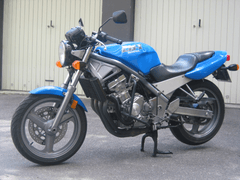Honda CB-1
The Honda CB-1 is a small, light naked sports motorcycle with a 399-cubic-centimetre (24.3 cu in) straight-four engine, carrying the model code NC27. In contrast to other models of the Honda CB series, the name is written with a hyphen. In some countries it was marketed as Honda CB400F.
 | |
| Manufacturer | Honda |
|---|---|
| Also called | CB400F, NC27 |
| Production | 1989–1990 |
| Class | Naked bike |
| Engine | 399 cc (24.3 cu in) liquid cooled DOHC four valves/cyl. inline-four |
| Bore / stroke | 55.0 mm × 42.0 mm (2.17 in × 1.65 in) |
| Compression ratio | 11.3:1 |
| Top speed | 190 km/h (118 mph)[1] |
| Power | 55.2 bhp (41.2 kW) @ 10,000 rpm (claimed)[1] |
| Torque | 29 lb⋅ft (39 N⋅m) @ 9,500 rpm (claimed)[1] |
| Ignition type | electric starter |
| Transmission | 6-speed chain drive manual |
| Frame type | Steel perimeter |
| Suspension | Showa. Front: 41 mm telescopic fork, non-adj. Rear: single shock w/7-way preload adj. |
| Brakes | Single disc front/rear |
| Tires | Bridgestone Front: 110/70-17 Rear: 140/70-17 |
| Rake, trail | 25.5 degrees, 99 mm (3.9 in) |
| Wheelbase | 1,370 mm (54 in) |
| Dimensions | L: 2,035 mm (80.1 in) W: 705 mm (27.8 in) |
| Seat height | 775 mm (30.5 in) |
| Weight | 179 kg (395 lb)[1] (dry) 187 kg (413 lb)[1] (wet) |
| Fuel capacity | 3.3 US gal (12 l; 2.7 imp gal) |
The bike was first introduced in 1989 and continued through 1990. Originally developed for the Japanese market, the CB-1 was also available in the United States and Canada. Called a "great motorcycle that never found an audience" and "victims of a difficult market" by Cycle World, the final model year 1990 CB-1s available as leftover stock were offered in 1992 at a $600 discount, for $3700 in the US, which in current money would be $6,741 accounting for inflation.[2]
The CB-1 engine is similar to the early NC23 models CBR400RR,[1] with changes to the port lengths and angles as well as smaller valves and lower compression ratio; changes in the primary and secondary gear ratios reduced the 60 mph (97 km/h) first gear down to around 30 mph (48 km/h), making the slightly less powerful CB-1 feel much quicker from a standstill than its sportier sibling, All engines derived from the NC23 block carry the NC23 ID code in the engine number; this includes the NC27, 23, 29, 31 etc., including the VTEC models with chain driven cams. Like many of its stablemates, the CB-1 has straight gear-driven dual camshafts with self-silencing gears to reduce whine.
Cycle World measured the time to cover a 1⁄4 mile (0.40 km) as 13.17 seconds with a final speed of 99.16 miles per hour (159.58 km/h) and the top speed as 118 miles per hour (190 km/h)[1] Braking distance from 60 to 0 miles per hour (97 to 0 km/h) was 124 feet (38 m).[1] — saying the bike was "a reincarnation of the standard motorcycle ... the sort of bike everyone rode before sporting riders went replica racer crazy".[1]
Gallery
- CB1a
- CB1
References
| Wikimedia Commons has media related to Honda CB1. |
- ""Honda CB-1; A new standard with the soul of a suburbanite and the heart of a tiger", Cycle World, New York, vol. 28 no. 4, pp. 44–47, Apr 1989
- Miles, Matthew (Apr 1989), "Best Buys; The affordable alternative to sticker shock", Cycle World, New York, vol. 28 no. 4, pp. 44–47